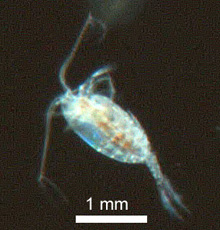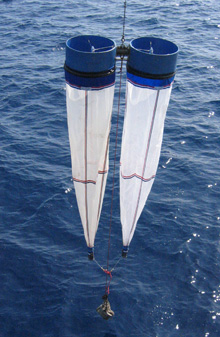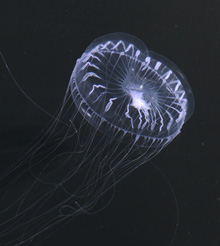Fig. 1. Paired bongo nets are lowered on a wire to a depth of 500 meters. Lead weight suspended between the nets will hold them vertical in the water. Replicate samples of zooplankton will be caught as the nets are slowly pulled up through the water column. The mesh size (the size of the openings in the net fabric) is 150 microns (0.15 millimeters), so these nets catch tiny organisms. The mouth of each bongo net is 60 centimeters, so most fast-swimming animals will sense them coming and escape. Image courtesy of 2007: Exploring the Inner Space of the Celebes Sea.
Our First Sampling Location
October 5, 2007 — Log 1
Talina Konotchick
Graduate Student – Biological Oceanography and Marine Biodiversity and Conservation
Scripps Institution of Oceanography
5º 05’ N, 120º 30’ E
After three days in transit we arrived at our first sampling location in the Celebes Sea, south of the Sulu Archipelago. The rain and clouds that we experienced coming out of Manila have all but disappeared, and it does not take long in the 90º F heat to break a sweat. We have blue skies, bright sun, and a humid breeze. The horizon is dotted with low-lying islands of the Sulu Archipelago. Some of them appear as a faint grey-blue patch in the distance, while others are close enough that one can just distinguish between the white sand and green vegetation. Although we are in sight of land, the bottom drops away very quickly. We are now over about 2,000 m depth of water. This is a good depth to do primary runs of all the instruments down to 500 meters (m) without fear of running these expensive instruments into the mud!The biological sampling has begun! We lowered bongo nets (fig. 1) down to 500 m for a vertical plankton tow. Some zooplankton vertically migrate on a daily basis, moving up to surface waters to feed at night when there is less chance of being eaten by visual predators. Because of this, we take replicate samples both in the day and at night to record changes in species and numbers in a specific location. Beautiful organisms from these plankton nets were brought aboard the ship and photographed under the microscopes. Some of the plankton we caught are an iridescent squid (5 centimeters) with red freckles on its mantle; a small pelagic polychaete worm (3 millimeters) with differentiated appendages; several gymnosome pteropods (shell-less pelagic molluscs about the size of a pea that swim by flapping a muscular modified foot); and the always-present copepods. Images of these are also being recorded with Nick Loomis' digital holographic imaging system.
Fig. 2. A jellyfish in the genus Aequorea swims in the planktonkreisel. A bluewater scuba diver caught this 50-millimeter-diameter medusa in a plastic jar and carried it back to the ship's lab for study. Image courtesy of 2007: Exploring the Inner Space of the Celebes Sea.
Fig. 3. The remotely operated vehicle (ROV), with headlights on and samplers at the ready, begins its descent. Bottom and top lids of the four large canisters on the frame in front of the ROV open hydraulically. The pilot slowly drives the ROV upward to encircle a large animal within one of the chambers, sliding both lids shut when it is completely inside. This tricky maneuver requires great skill, because the pilot views the scene through a two-dimensional camera lens, not with 3-dimensional optics. Image courtesy of 2007: Exploring the Inner Space of the Celebes Sea.
In the evening of October 4, Cabell Davis deployed his color video plankton 4ecorder for the first time. Emory Kristof and his RopeCam team, Mike Cole and Ralph White, deployed the RopeCam rig with empty camera housings to test them for leaks. They will start taking pictures on the bottom in a day or two, using fish carcasses to lure in hungry creatures to pose for their portraits.
On the morning of October 5, conditions for the first bluewater dive were ideal: calm seas, no wind, and 80-foot visibility. The water is a tepid 85º F — not quite the refreshing respite from the heat one might desire! On this first dive, Erich Horgan was safety diver. In their half hour underwater, Larry Madin and Greg Stone observed and collected 19 gelatinous specimens in plastic jars, while Nick Caloyianis and Lee Caughron videoed both the divers and the free-swimming plankton. During the dive they heard a loud explosion underwater. The likely culprit for this blast was dynamite fishing, unfortunately a common practice in this area. The actual explosion was not heard or observed from the ship and was probably some distance away, because sound travels particularly well underwater compared to air.
Back aboard ship, the scientists transferred the gelatinous zooplankton into containers for preservation or into glass dishes and the planktonkreisels (aquariums designed for gelatinous animals) for observation and photography (fig. 2). When we had a chance to look closely at the collected specimens we realized that some of them look slightly different from similar species in other parts of the ocean. After we return home, DNA analysis will determine if these are indeed new species!
After lunch an ROV dive was scheduled, but soon after the ROV submerged, the pilot and scientists watching the high-definition (HD) video monitor saw bubbles rising in the image. They realized that camera's housing-dome seal was leaking and seawater was seeping into the housing! Luckily, the camera was pointed down and the ROV was lifted out of the water before the camera got damaged. Toshi Mikagawa concluded that the leak occurred because the high temperature out on deck caused the housing's dome to expand, breaking the watertight seal. A new dome on the housing corrected the problem and the ROV continued to record great images.
With the housing repaired, the ROV dived again, (fig. 3), this time getting close to its limit of 3,000 m (almost 2 miles down!). On the way down the HD camera recorded plankton and marine "snow," and a couple of red squid dashed across the camera's field of view. Emory hoped to reach the sea floor to see what the bottom looked like before deploying his RopeCams, but the ROV couldn't dive deeper and had to surface without locating the bottom. It was a late night for all of us, because everyone wanted to watch the live picture seen through the HD camera, and the ROV crew stayed up past 2 am to secure the ROV and its sampling instruments.






























